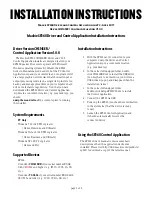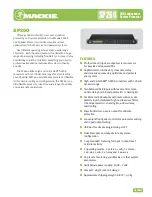
2
Installing the Hardware and Software
8
Considering Antenna Placement
You can place the antenna either indoors or outdoors. An outdoor location, such as a
rooftop, provides the following advantages:
■
Fewer obstacles to signal paths between wireless bridges
■
Increased antenna range
■
Fewer multipath problems
Proper Grounding
To ensure the physical safety of anyone near the antenna and to prevent damage to
the wireless bridge, follow the building codes for antenna installations in your area.
This approach typically means making certain that antennas and antenna masts are
appropriately grounded to prevent injury or damage from lightning strikes.
Most of the antennas shipped with the wireless bridge do not have an electrical connection
between the mask mount and the coaxial cable shield. However, adding a lightning arrestor
will correct that situation by grounding the outer shield as recommended. In some arrestor
designs, there is also some over-voltage protection for the signal sent down the cable. If you
use such a component, be sure that it is designed to pass signals used in the 2.5 GHz signal
range (many inexpensive units are available with F connectors, but these are typically
designed for cable TV-UHF applications and may degrade the signals in the band used by
the wireless bridge).
Alignment
Position each antenna so that there are minimal obstacles between it and any other
antenna with which it will communicate. While maintaining a direct line of sight between
antennas is not strictly necessary, such an arrangement helps to ensure a strong signal.
Align each directional antenna to point at the antenna with which it will communicate.
If you place two directional antennas at different heights, tilt them up or down toward
each other for optimal signal strength. Make sure that the angle of tilt is identical for each
antenna: the antenna faces should be parallel.
While aligning the antenna, you may want to use the Wireless Bridge Manager Received
Signal Strength Indicator (RSSI) Monitor tool (preferably loaded on a mobile PC that can
be used at the antenna site) to adjust the antenna to achieve the maximum possible
received signal strength. See “Viewing Signal Strength with the RSSI Monitor” on page 36
for more information.
Polarization
Polarization is a physical phenomenon of radio signal propagation. In general, any two
antennas that are to form a link with each other must be set for the same polarization.
If for example, two antennas for a link are linearly polarized, they must both be vertically
polarized or horizontally polarized. If both antennas do not have the same polarization,
the link will either work poorly, or not at all.The situation where one antenna is vertically
polarized and the other is horizontally polarized is known as cross-polarization.
Antenna polarity should be identical for each antenna in a bridging link or network.
Vertical polarization is preferred in most cases. Make sure that every directional antenna is
properly oriented for vertical polarization (according to the polarization indicator shown
on the antenna panel).
Omnidirectional antennas should be vertically aligned in relation to the ground.















































